Hot tea and exercise associated with lower laucoma risk
by Liz Hillman, Ophthalmology Business Staff Writer March 2018 issue of EyeWorld. Con permiso de EyeWorld.
Por:
Liz Hillman
Ophthalmology Business Staff Writer
Recent studies look at life-style changes to potentially reduce risk for sight-threat- ening disease.
What do a daily cup of hot tea and regular moderate to vigorous exercise have in common? Besides being part of a generally healthy lifestyle, recent research from separate studies has shown both to have an association with lower glaucoma risk. Two studies from the University of California, Los Angeles, established that people who drank hot tea daily or participated in what was considered moderate to vigorous exercise were 74% and 73%, respectively, less likely to have glaucoma.
Anne Coleman, MD, Fran and Ray Stark professor of ophthalmology, Stein Eye Institute, and professor of epidemiology, Fielding School of Public Health, UCLA, is quick to note that this association does not establish causation, but adopting these lifestyle changes as a potential preventive measure can’t hurt.
“It’s important for [glauco-
ma specialists] to educate their patients that they must take their medications and keep up with their follow-ups, but I think there’s also the potential for them to discuss lifestyle modifications that might help—they might not, but they might,” Dr. Coleman said. “If patients are aware of it and can potentially change their habits, this might low- er their pressure and protect their optic nerve in the future.”
One study1 published in the British Journal of Ophthal- mology evaluated caffeinat- ed and decaffeinated coffee, iced tea, hot tea, and soft drink consumption among a population of 1,679 survey participants weighted with the National Health and Nu- trition Examination Survey (2005–2006) design. The intent of the study was to evaluate caffeinated and de- caffeinated drinks and glau- coma because previous re- search had shown both could be associated with tempo- rarily elevated IOP.
About 5% of the survey participants had glauco- ma. While there was no statistically significant as- sociation between drinking caffeinated or decaf- feinated coffee, iced tea, decaffeinated hot tea, or soda and glaucoma risk, the study authors ob- served that those who drank at least one daily cup of hot tea were 74% less likely to have glaucoma.
“This is an association, it’s not a causation,” Dr. Coleman reminded.
What could be driving it?
“Prior studies have noted an oxidative and neu- rodegenerative aetiology in the pathogenesis of glaucoma, suggesting that antioxidants may play a protective role in glaucoma,” Wu et al. wrote in the study. “Additionally, flavonoids have been shown to inhibit the vascular endothelial growth factor receptor, and potentially prevent neovascu- lar glaucoma, fibrotic scar tissue formation after glaucoma surgery and neurodegeneration.”
Why was this effect seen in caffeinated tea but not caffeinated coffee or iced tea? Dr. Coleman speculated this could be because the antioxidants and other compounds in coffee are different than that of tea, and the caffeine level in coffee is high- er. As for iced tea, Dr. Coleman said it could be the study’s sample size was too small or that peo- ple could be drinking bottled iced tea, not home- brewed, which could carry preservatives or some- thing else counteracting a benefit.
“But it’s hard to know until we get more informa- tion,” Dr. Coleman said.
While it’s not definitive that the act of drinking a hot cup of caffeinated tea daily will reduce one’s risk for glaucoma, Dr. Coleman said, doing so can’t hurt.
“If someone is drinking hot tea, they should keep on drinking it. Whether coffee drinkers should switch to hot tea, coffee has benefits in other dis- eases, but it might be they want to consider hav- ing a cup of tea as well,” Dr. Coleman said.
Another study2 that was presented as a poster at the 2017 American Academy of Ophthalmol- ogy annual meeting from Dr. Coleman’s team looked at exercise and its association with glau- coma risk. Lead researcher Victoria Tseng, MD, and her fellow investigators also used the Na- tional Health and Nutrition Examination Survey, looking at exercise intensity among the popu- lation as measured by a pedometer as well as self-reported. In this study, 3.1% of the weight-
ed population had glaucoma. The most physically active in the study were 73% less likely to have glaucoma compared to those who were the least active.
In addition to time spent exercising per week, intensity mattered.
“You can do it walking, it’s just you need to walk at a faster clip,” Dr. Coleman said. “That becomes important because with diseases like glaucoma and cataracts, we start losing our vision and our depth per- ception, so patients get more fearful of fall- ing and slow down their pace. It becomes like a catch-22 for patients. Keeping up one’s pace is important for heart health and the whole aging process. … Maybe get on a stationary bike if that’s going to help you keep up your pace.”
Overall, Dr. Coleman thinks patients are more open to lifestyle changes they could be making.
“They want to know ‘What can I do?’ and that’s why we’ve been looking into these different potential behavioral modifica- tions,” Dr. Coleman said. “Patients are much more involved, and if there is a be- havioral modification that they can do, we want them to do it.”
In terms of future studies to potentially es- tablish a more definitive link between exer- cise or hot tea drinking, for example, and reduced risk for glaucoma, Dr. Coleman said that becomes difficult because “you can’t randomize people to lifestyle behaviors.”
References
- Wu CM, et al. Frequency of a diagnosis of glaucoma in individuals who consume coffee, tea and/or soft drinks. Br J Ophthalmol. 2017 Dec 14. Epub ahead of print.
- Tseng VL, et al. Exercise intensity and risk of glauco- ma in the National Health and Nutrition Examination Survey. Poster at the 2017 American Academy of Ophthalmology annual meeting.
Editors’ note: Dr. Coleman has no finan- cial interests related to her comments.
Contact information
Coleman: coleman@jsei.ucla.edu

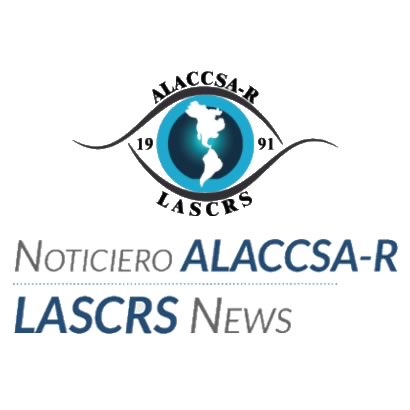

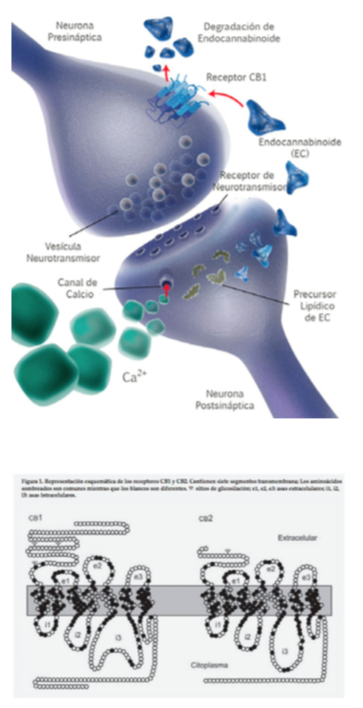
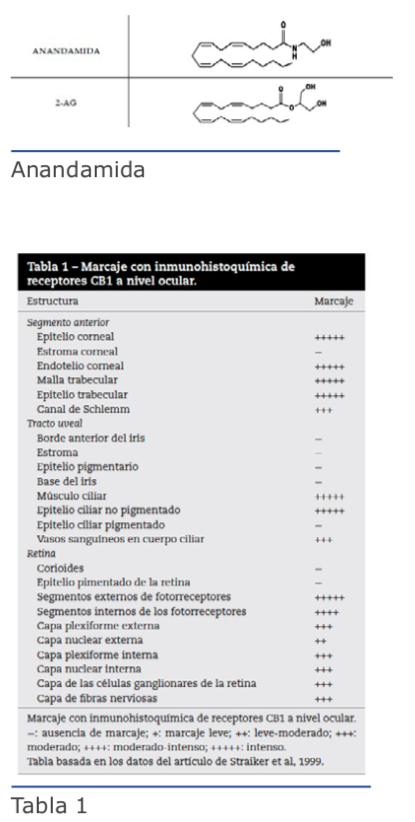 Si bien hay varias sustancias a las que se le atribuyen propiedades neuroprotectoras, como la cúrcuma, el ginkgo biloba, la brimonidina, etc., aún no hay trabajos concluyentes sobre los beneficios a largo plazo.
Si bien hay varias sustancias a las que se le atribuyen propiedades neuroprotectoras, como la cúrcuma, el ginkgo biloba, la brimonidina, etc., aún no hay trabajos concluyentes sobre los beneficios a largo plazo.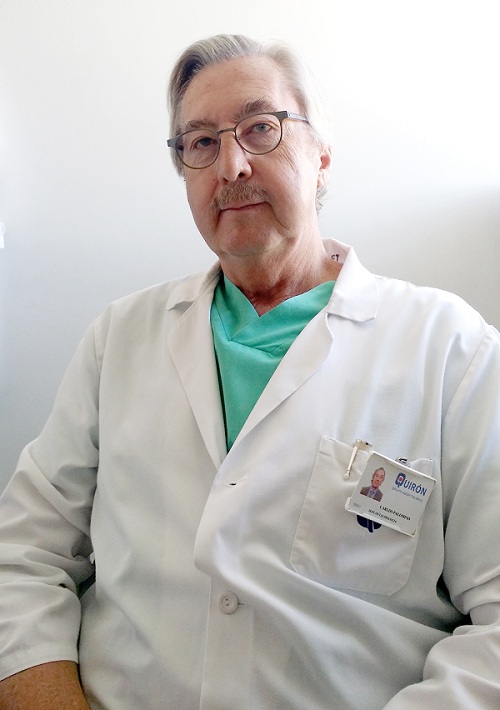
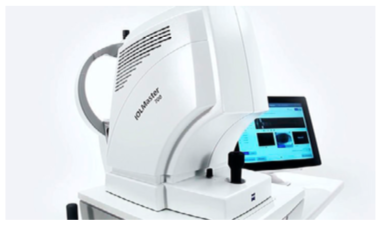

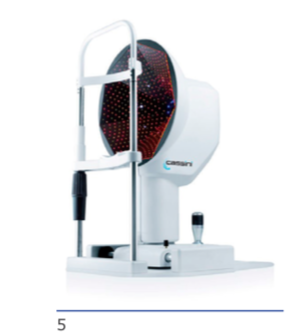


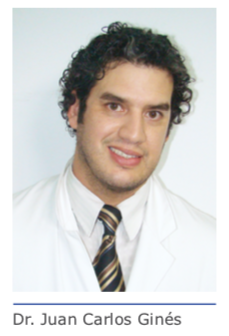


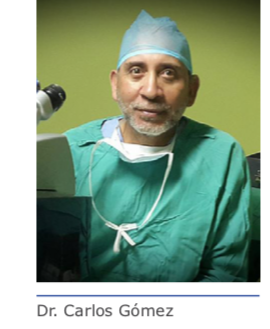

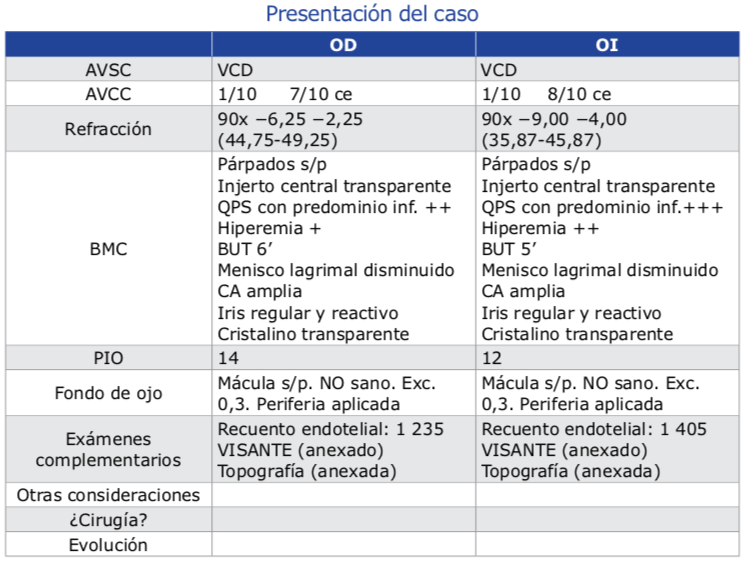
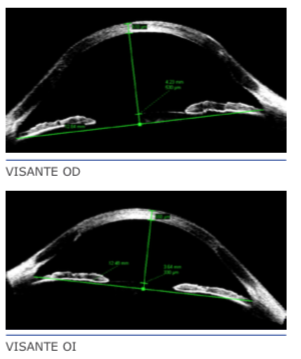

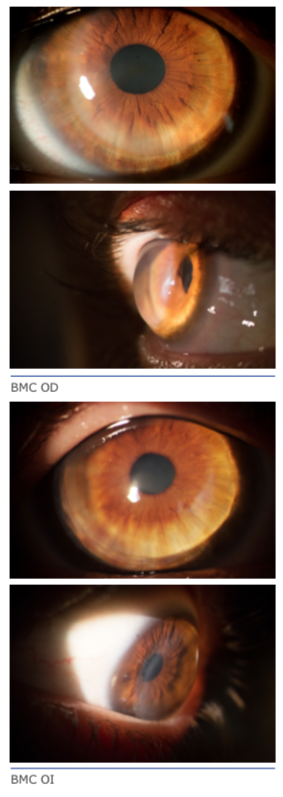
 Al ser los resultados quirúrgicos de las diferen- tes técnicas (arcuatas, puntos de tracción so- bre el meridiano plano, ICRS, resecciones en cuña, queratoplastias lamelares tectónicas sectoriales, etc.) bastante poco predecibles y estables en el tiempo, preferimos ser conser- vadores en un principio y tratar el defecto re- fractivo mediante diferentes tipos de lentes de contacto (rígidas, gas permeables, piggyback, híbridas, apoyo escleral), así como mejorar la superficie ocular con los tratamientos anterior- mente descritos.
Al ser los resultados quirúrgicos de las diferen- tes técnicas (arcuatas, puntos de tracción so- bre el meridiano plano, ICRS, resecciones en cuña, queratoplastias lamelares tectónicas sectoriales, etc.) bastante poco predecibles y estables en el tiempo, preferimos ser conser- vadores en un principio y tratar el defecto re- fractivo mediante diferentes tipos de lentes de contacto (rígidas, gas permeables, piggyback, híbridas, apoyo escleral), así como mejorar la superficie ocular con los tratamientos anterior- mente descritos.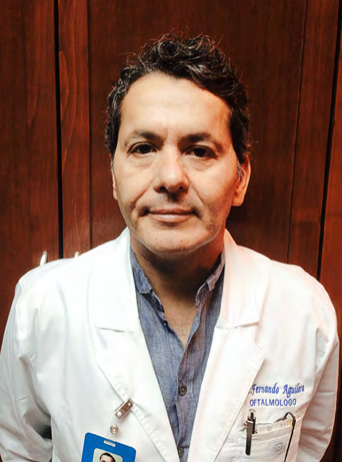
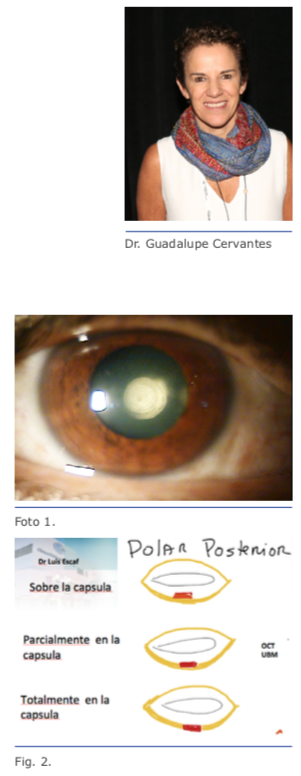 1. Catarata polar posterior por encima de la cápsula posterior (Fig. 2).
1. Catarata polar posterior por encima de la cápsula posterior (Fig. 2).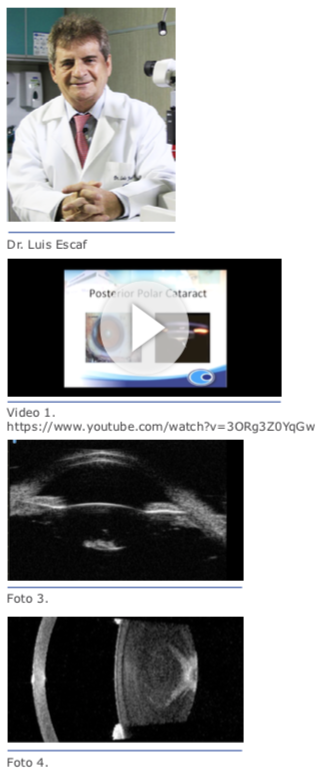 Si definitivamente es una catarata polar posterior dura, como se supone en este caso, por la edad del paciente, me voy limitar a describir como no- sotros abordamos este tipo de cataratas.
Si definitivamente es una catarata polar posterior dura, como se supone en este caso, por la edad del paciente, me voy limitar a describir como no- sotros abordamos este tipo de cataratas.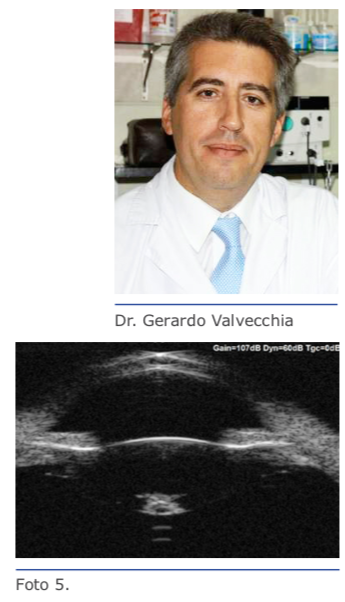 Dr. Luis Escaf: De antemano a la cirugía uno debe planear qué tipo de LIO va implantar. Puede ser un multifocal, un monofocal o un tórico, pero tener a la mano un monofocal de tres piezas o de una sola pieza. En caso de que no se pueda implantar el LIO premium, se decide por monofocal y, dependiendo de la RCP, se implanta en sulcus o saco, pudiéndose abotonar ya sea por delante o por detrás de la rexis o, en algunos casos, en la capsulorrexis posterior (ver video de Ike Ahmed).
Dr. Luis Escaf: De antemano a la cirugía uno debe planear qué tipo de LIO va implantar. Puede ser un multifocal, un monofocal o un tórico, pero tener a la mano un monofocal de tres piezas o de una sola pieza. En caso de que no se pueda implantar el LIO premium, se decide por monofocal y, dependiendo de la RCP, se implanta en sulcus o saco, pudiéndose abotonar ya sea por delante o por detrás de la rexis o, en algunos casos, en la capsulorrexis posterior (ver video de Ike Ahmed).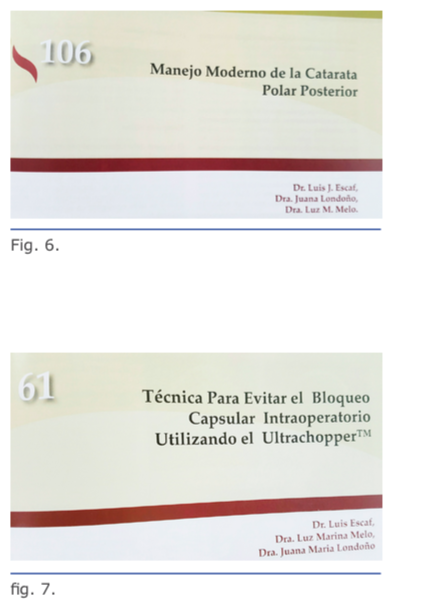 Cualquier vitréctomo neumático que trai- ga el equipo de facoemulsificación de más de 1.200 cortes sirve. A todos los facoemul- sificadores se les pueden adaptar piezas de mano de vitréctomos 23 G, solo debemos asesorarnos a cuantos PSI trabaja nuestro equipo para comprar las piezas adecuadas.
Cualquier vitréctomo neumático que trai- ga el equipo de facoemulsificación de más de 1.200 cortes sirve. A todos los facoemul- sificadores se les pueden adaptar piezas de mano de vitréctomos 23 G, solo debemos asesorarnos a cuantos PSI trabaja nuestro equipo para comprar las piezas adecuadas.
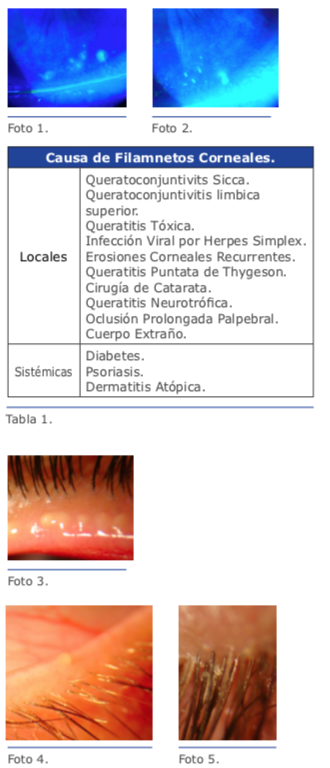 El párpado es una estructura anexa que nos puede dar más de un dolor de cabeza en el pre y posoperatorio sino le damos la importancia que se merece. Los párpados deben estar completamente sanos para proceder a una eventual cirugía intraocular y para ello su análisis debe ser minucioso y obligatorio. Foto 3.
El párpado es una estructura anexa que nos puede dar más de un dolor de cabeza en el pre y posoperatorio sino le damos la importancia que se merece. Los párpados deben estar completamente sanos para proceder a una eventual cirugía intraocular y para ello su análisis debe ser minucioso y obligatorio. Foto 3.
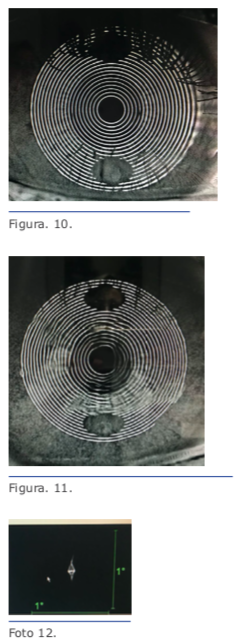 En la figura 10 podemos ver la in- tegridad de los anillos mientras que en la figura 11 se aprecia ya un des- vanecimiento de los anillos.
En la figura 10 podemos ver la in- tegridad de los anillos mientras que en la figura 11 se aprecia ya un des- vanecimiento de los anillos.
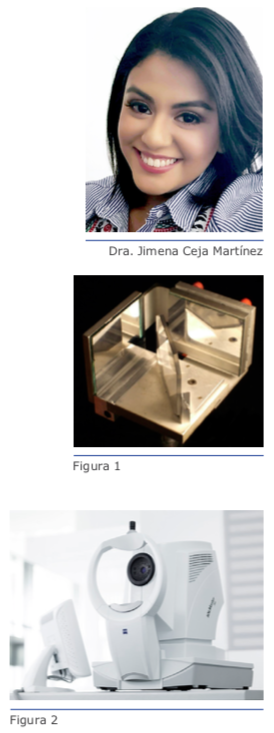 La biometría óptica o interferometría de coherencia parcial utiliza una fuente de luz con coherencia parcial que funciona como un interferómetro de Michelson (Figura 1). Los biómetros ópticos miden de la córnea al EPR, en cambio los biómetros ultrasónicos miden de la córnea a la membrana limitante interna. Los primeros permiten realizar mediciones de no contacto, rápidas y precisas, a diferencia de la biometría ultrasónica.
La biometría óptica o interferometría de coherencia parcial utiliza una fuente de luz con coherencia parcial que funciona como un interferómetro de Michelson (Figura 1). Los biómetros ópticos miden de la córnea al EPR, en cambio los biómetros ultrasónicos miden de la córnea a la membrana limitante interna. Los primeros permiten realizar mediciones de no contacto, rápidas y precisas, a diferencia de la biometría ultrasónica.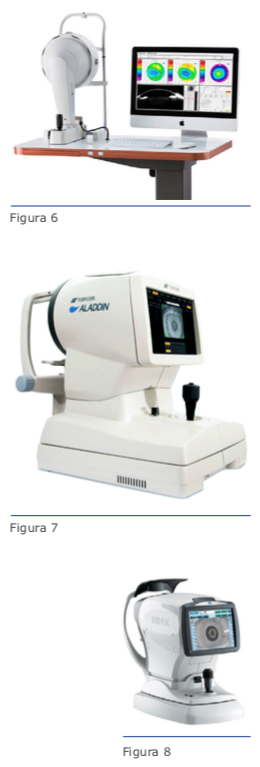 El biómetro OA-2000 (Tomey), utiliza una tomografía de coherencia de fuente de barrido o espectral, que permite una mayor penetración a los tejidos (Fig. 5):
El biómetro OA-2000 (Tomey), utiliza una tomografía de coherencia de fuente de barrido o espectral, que permite una mayor penetración a los tejidos (Fig. 5):
 En 2012 Holladay5 estudió las DN provocadas en un globo ocular simulado, diseñado con un programa especial, considerando un LIO de acrílico, de 6 mm de diámetro y 20 D, pupila de 2,5 mm y observó que, al incidir un haz luminoso, se producían dos anillos completos, de 360° que al sobreimprimirlos
En 2012 Holladay5 estudió las DN provocadas en un globo ocular simulado, diseñado con un programa especial, considerando un LIO de acrílico, de 6 mm de diámetro y 20 D, pupila de 2,5 mm y observó que, al incidir un haz luminoso, se producían dos anillos completos, de 360° que al sobreimprimirlos